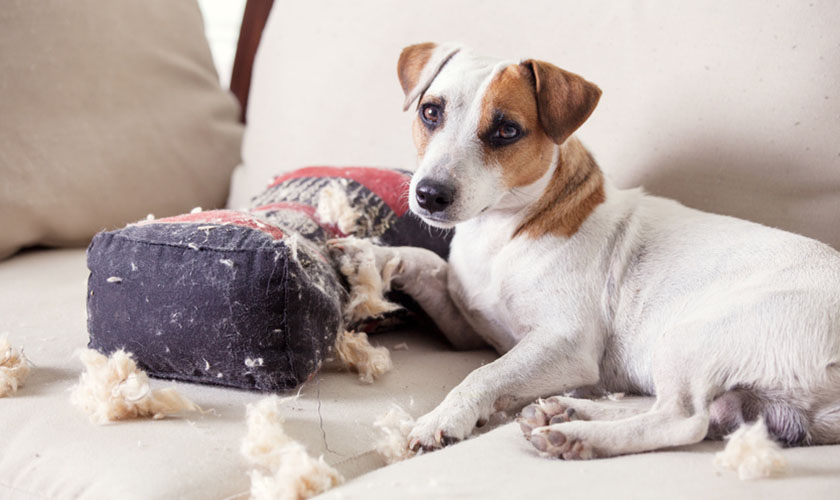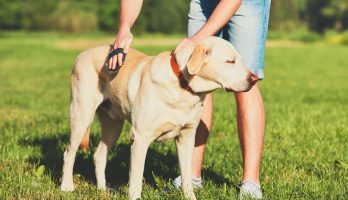Like most pets, dogs usually live with a clearly determined routine with which they feel comfortable. This regular rhythm, which varies from one home to another, determines the animal’s daily life and its well-being. Thus, when a change of family home is taking place, the dog’s routines will be upset and the stress it places on him may make him react in strange ways. The dog will be anxious, won’t understand what’s going on and may even be worrying if he’s going to see his master again. He might act out these worries by hiding in a corner, under a table or even in one of the removal boxes.
Later on, the stress might cause problems with the dog’s obedience especially once the move to a new home has been made. In an attempt to avoid these issues it’s always advisable to do some advance preparation. Keep the dog away from the bustle of packing by making it comfortable in an already emptied room leaving him with just his bed, some water, a couple of bones and his favorite toys. Once these precautions have been made, then it will be necessary to think about training the dog so that a change of environment doesn’t unduly disrupt his behavior. This training should take the same course that would be followed for any change occurring in the home, such as the arrival of a new family member. Everyone will benefit if the changes in a dog’s living environment are preceded and followed by a few well-chosen training strategies.
Adapting the dog’s behavior according to the environment
There are several situations which might affect a dog’s living environment, thus making him feel nervous and insecure. These might be a house move, some new decor, or simply rearranging the furniture in the home. All of these things have an impact on the animal’s living space. So, if a move is taking place, it’s best to leave the dog on its own in an empty room until the removal is complete. Afterwards, some modification in his behavior through training may be necessary. The best way to achieve this is by simply leaving him alone and giving him space and autonomy to explore his new environment and gradually adapt to it. For the first few nights after the move, leave the dog in the kitchen or a spare room where he can be on his own with his bed. These rooms are usually unoccupied and do not contain large or overpowering objects. They are also easy to clean. To start with the dog might whine, complaining that he is lonely in this new environment but his master must not give in to the dog’s complaints if the training is to be successful. If he gives in even once, his four-legged companion will not be happy returning to the room on his own and this will compromise the success of the training program. Also, during these first few days, if the dog’s owner has to go out he should distance himself a little from the animal both before he leaves and when he returns. Alongside these strategies, strictness must be followed because in response to his new environment the dog might begin to exhibit some destructive tendencies. Any such tendencies should be immediately reprimanded so that the animal associates this bad behavior with a punishment. In this way, he will quickly learn. It should be pointed out here that the time gap between the incorrect behavior and the punishment must be very short otherwise they are not linked in the dog’s mind and become useless.
The outside surroundings of the new home also constitute a new environment for the dog. Here, the method of adapting the dog’s habits needs to be chosen according to the presence or not of any outbuildings. If there is a garden, this might turn out to be an area where the dog feels happy and relaxed and is, probably, where his kennel or shelter will be situated. He will soon feel at home in the garden if he is introduced to it slowly. If the fence is secure he can be left alone in the garden for short periods, especially if his shelter is already there and, if possible, he can also have his meals in the garden. In situations where there is a yard instead of a garden, a few moments of playtime here will soon help the dog accept this new environment. Finally, if the new home has no outside space, taking the dog for a walk on his leash will quickly acclimatize him to the surrounding area. Ideally, these first walks should be on quiet, uncrowded streets or in a local park.
Adapting the behavior of dogs towards new companions
Whatever the circumstances, it’s always vital that dogs are socialized and able to mix safely with either humans or other animals. Some dogs may have an aggressive attitude towards humans if they are not familiar with them but if a new baby joins the family or a friend or relative moves in the four-legged companions must become used to the situation. This can be achieved by making sure the newcomer is present at key moments during the dog’s day such as when games are being played or it is eating. To start with, make sure the dog stays in the room with the newcomer and reprimand him if he shows any signs of aggression. If the newcomer is an adult they could feed the dog or accompany the dog and his owner at playtimes or on walks. By making enjoyable moments with this newcomer a habit, the dog’s brain will register the new presence as a positive change to his living environment.
If on the other hand, the new companion living alongside the dog is another dog then a different training technique is required. This may be as simple as feeding both dogs at the same time, taking them for walks on the leash at the same time or simultaneously playing with them both. To help ensure a smooth transition to living with another dog avoid any sudden changes to the original dog’s known routines. His bed shouldn’t be moved or used by the new animal, his own toys should always be easily available and his bowl shouldn’t be moved or shared. Of course, once he is accustomed to his new friend, there is no harm in encouraging them to share their toys and use the same bowls and beds. Even more tact and care are needed if the dog is having to cope with the arrival of a different species of animal. Before any games or walks are enjoyed together, the dog must have a chance to see and sniff the newly arrived pet. By making sure he is securely held on a leash while this happens he can safely be introduced to the new arrival without doing it any harm. Gradually they will learn to live side by side in harmony.
To ensure a dog’s obedience and to train him into behaviors that ensure a healthy lifestyle, the dog’s psychological state is very important, especially when changes are happening to his environment. Therefore, the animal must be fully prepared while his master needs to be extremely patient and caring while also being strict. By following these guidelines any changes to the dog’s environment should take place smoothly and without stressful incidents.





